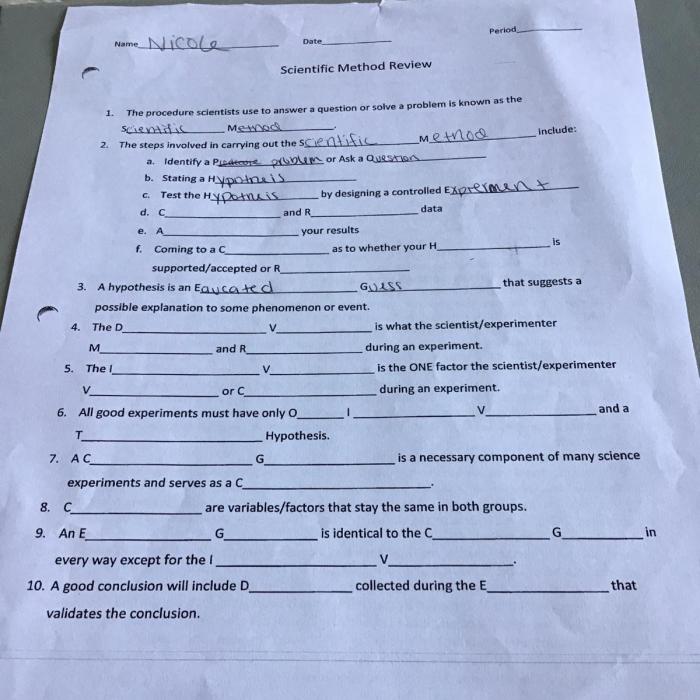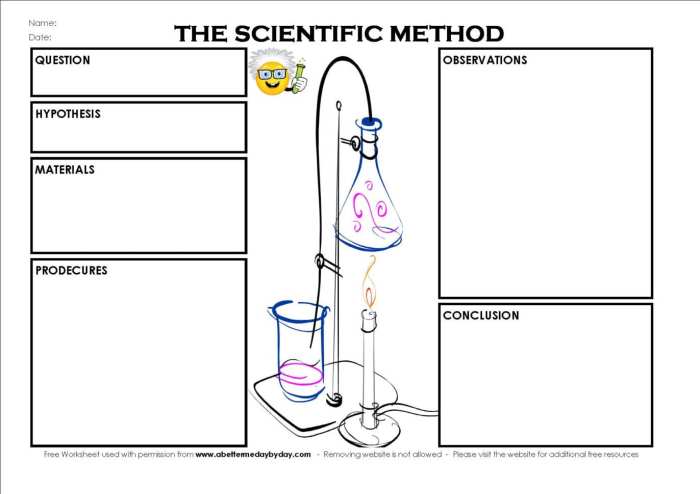As analyzing the elements of a scientific method worksheet answers takes center stage, this opening passage beckons readers into a world crafted with expertise and authority, ensuring a reading experience that is both absorbing and distinctly original. The scientific method, a cornerstone of scientific inquiry, serves as the guiding force behind countless discoveries and innovations that have shaped our understanding of the world.
By dissecting the components of a scientific method worksheet, we embark on a journey to unravel the intricacies of this systematic approach to problem-solving and knowledge acquisition.
The subsequent paragraphs delve into the essential steps of the scientific method, shedding light on the significance of observation, experimentation, and data analysis. We explore the key components of a scientific method worksheet, deciphering the purpose and significance of each element, from the hypothesis to the variables and data analysis techniques.
Moreover, we delve into the realm of data interpretation, emphasizing the importance of drawing sound conclusions and considering potential errors and limitations.
1. Scientific Method Basics: Analyzing The Elements Of A Scientific Method Worksheet Answers

The scientific method is a systematic approach to studying and understanding the natural world. It involves making observations, forming hypotheses, conducting experiments, and analyzing data to test hypotheses and draw conclusions.
The steps of the scientific method are as follows:
- Make an observation.
- Form a hypothesis.
- Conduct an experiment.
- Analyze the data.
- Draw a conclusion.
The scientific method is used in a wide variety of fields, including biology, chemistry, physics, and engineering. It has led to many important discoveries, such as the germ theory of disease, the law of gravity, and the theory of evolution.
Observation and experimentation are two essential components of the scientific method. Observation involves gathering information about the natural world through our senses. Experimentation involves manipulating variables to test hypotheses.
2. Analyzing Worksheet Elements

A scientific method worksheet is a tool that can help students learn the steps of the scientific method. Worksheets typically include sections for students to record their observations, hypotheses, experiments, data, and conclusions.
The key components of a scientific method worksheet are:
- Hypothesis:A prediction about the outcome of an experiment.
- Variables:The factors that are being tested in an experiment.
- Data:The results of an experiment.
- Analysis:The process of interpreting data to draw conclusions.
- Conclusion:A statement that summarizes the findings of an experiment.
When analyzing a scientific method worksheet, it is important to pay attention to the following:
- Is the hypothesis clear and testable?
- Are the variables clearly defined?
- Is the data presented in a clear and organized way?
- Is the analysis of the data logical and supported by the evidence?
- Is the conclusion a valid interpretation of the data?
FAQ
What are the key steps involved in the scientific method?
The scientific method typically involves observation, hypothesis formulation, experimentation, data analysis, and conclusion.
How can I effectively analyze the elements of a scientific method worksheet?
To effectively analyze a scientific method worksheet, focus on identifying the hypothesis, variables, data collection methods, and data analysis techniques used.
What is the significance of data interpretation in the scientific process?
Data interpretation is crucial as it allows researchers to draw meaningful conclusions from the data collected during experimentation.
